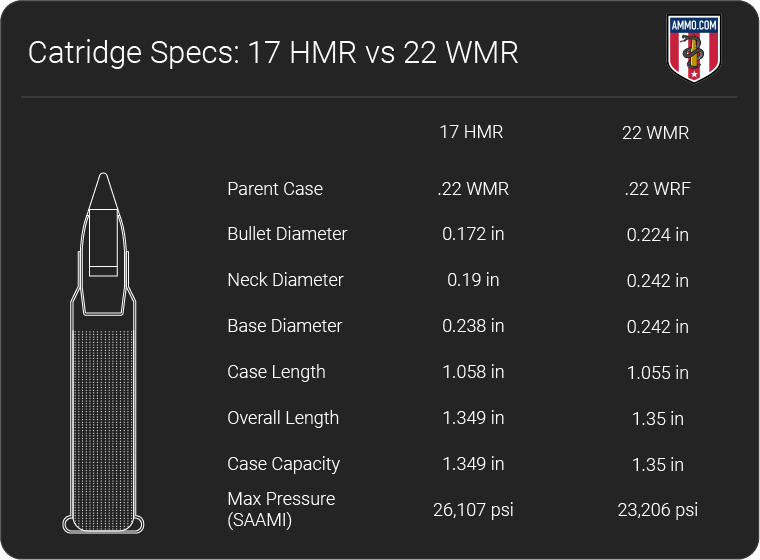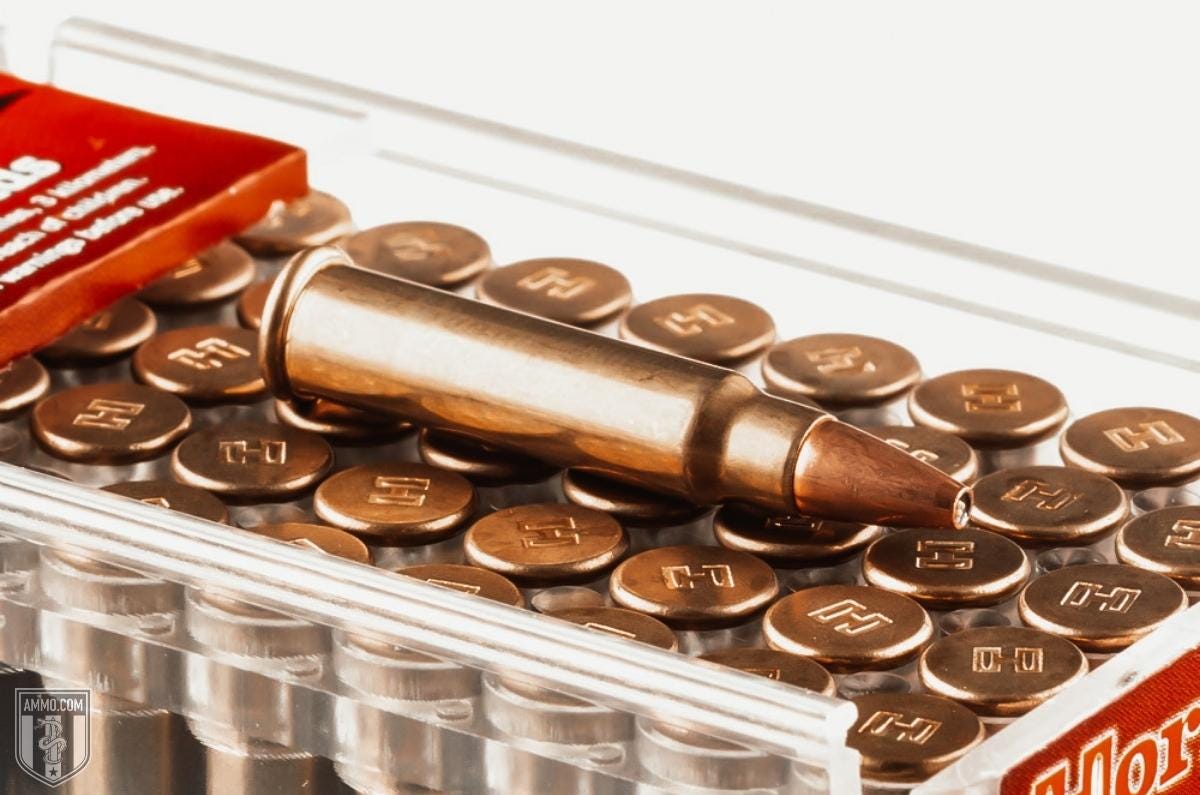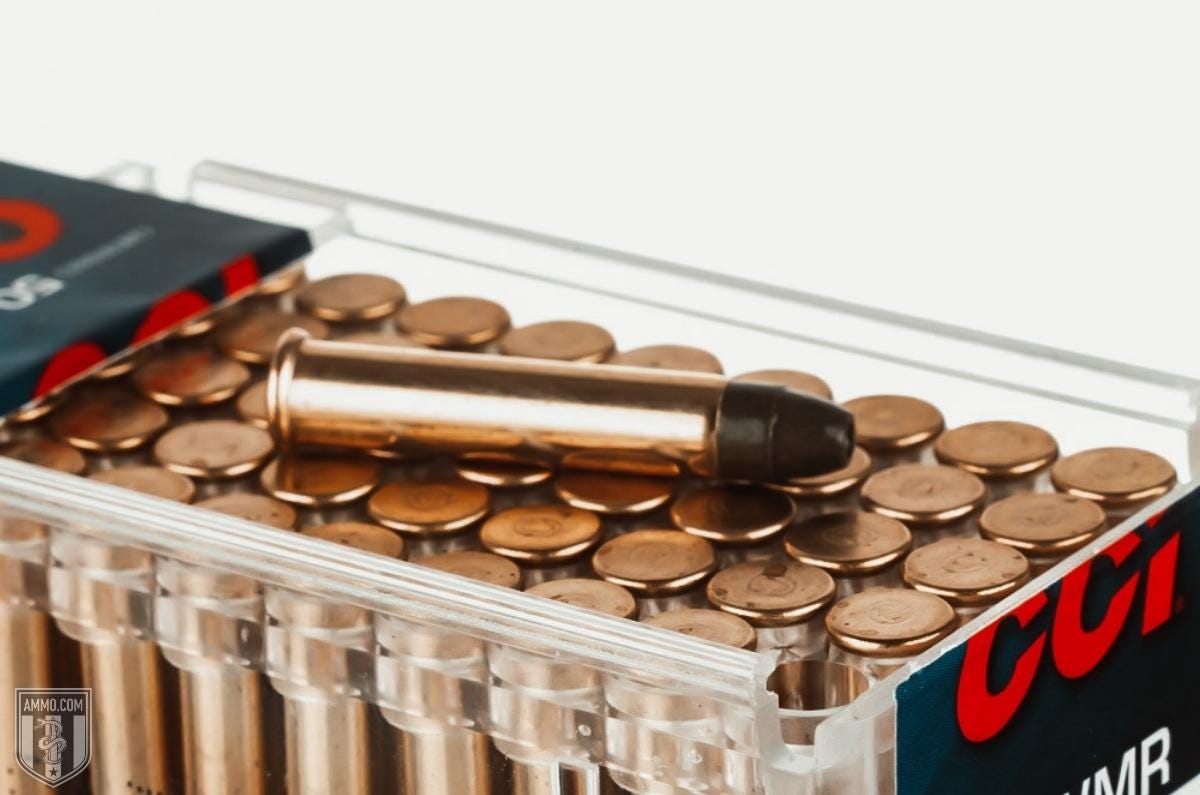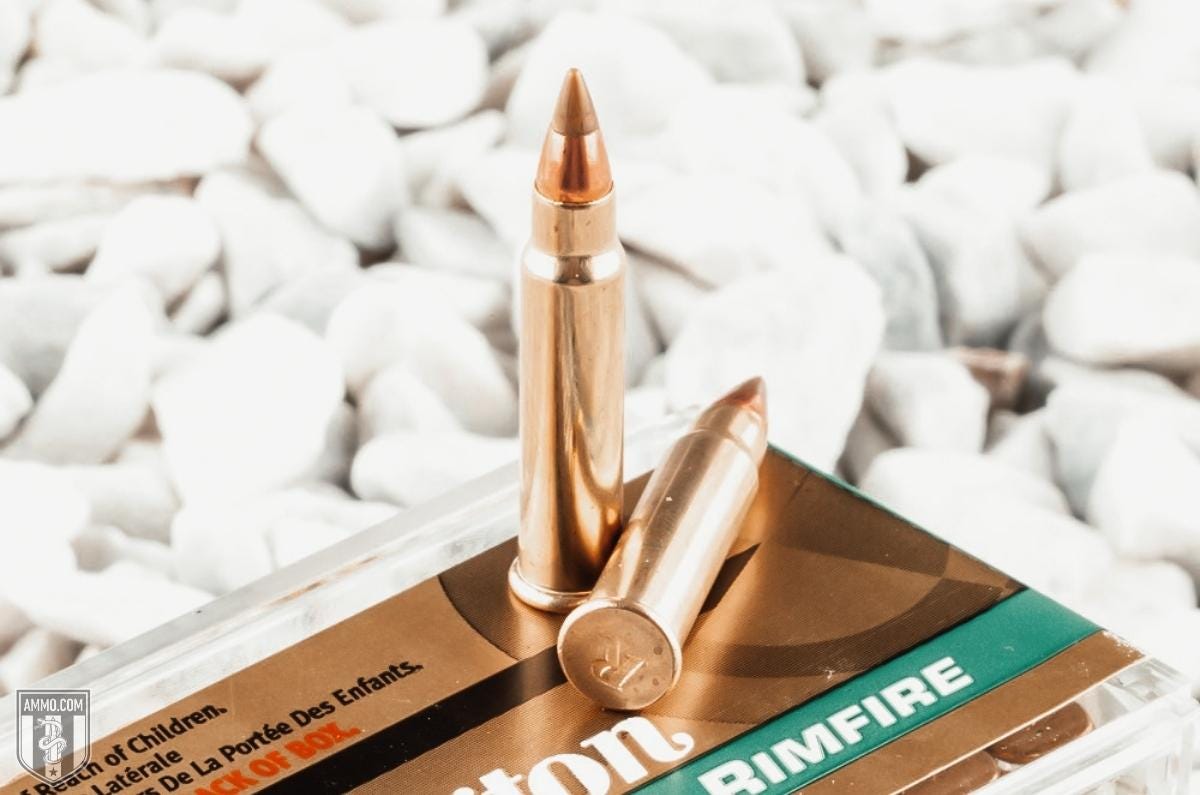17 HMR vs 22 Mag: The Magnum Rimfire Cartridge Roundup
17 HMR vs 22 Mag is a question that varmint hunters constantly debate. Are 17 HMR ballistics good enough for small game hunting or is 22 WMR superior?
In the land of the rimfire rifle cartridge, the 22 long rifle with its 40-grain bullet remains the most popular round for plinking and light pest control.
However, sometimes a .22LR simply isn’t powerful enough to take on larger varmints, like coyotes, and lacks the muzzle velocity to take down prairie dogs at longer ranges.
To take on these larger critters, you need a rifle cartridge that has more muzzle energy and higher velocity. This situation reminds me of watching Star Trek back when I was a child and listening to Captain Kirk call down to Scotty and tell him, “We need more power!”
And I have no doubt that if Mr. Scott were a ballistician, he would present Captain Kirk with something along the lines of the 22 Winchester Magnum Rimfire (WMR) or the 17 Hornady Magnum Rimfire (HMR).
The 22 WMR, more commonly known as 22 Mag, and 17 HMR are two magnum rimfire cartridges that excel at long range varmint hunting. The 17 HMR is known for its flat trajectory and high muzzle velocity, while the 22 WMR can fire a heavier bullet and really bring the ft-lbs of pain to unsuspecting varmints.
But which rimfire round will work best for your needs?
In this article, we will compare the 17 HMR vs 22 WMR to help you select the best round for your next bolt action rimfire rifle.
What is the Difference Between 22 Mag and 17 HMR?
The main difference between 22 WMR (22 Mag) and 17 HMR is bullet diameter each rimfire cartridge fires. The 17 HMR fires a 0.172” diameter bullet and the 22 Mag fires a 0.224” diameter bullet.
Both rimfire cartridges are used for varmint and small game hunting, but the 17 HMR has a flatter trajectory while the 22 WMR bullets carry more ft-lbs of kinetic energy.
Cartridge Specs
When comparting two rimfire cartridges, it’s important to look at the case specs to get a better idea of the capabilities of each.
Comparing the 17 HMR vs 22 WMR, you’ll notice that the only major difference is the bullet diameter each cartridge fires. This is because 17 HMR is simply a 22 WMR case necked down to accept a 0.172” bullet.
This means that the 17 HMR will shoot lighter bullets at a higher muzzle velocity while the 22 WMR will shoot heavier bullets, based on diameter alone.
The 17 HMR is typically loaded with a 17 grain V-MAX polymer tipped bullet around 2,550 fps and 245 ft-lbs of muzzle energy. Some 15.5 and 20 grain bullets are available, but the majority of factory loads sport 17 grain bullets.
In contrast, the 22 WMR can be loaded with bullets generally between 30 and 50 grains, with the 40-grain bullet being the most common option. Your typical 22 WMR 40 grain jacketed hollow point will be traveling at 1,910 fps and have 324 ft-lbs of muzzle energy.
The 17 HMR clearly has a higher velocity while the 22 WMR hits harder, but there’s a little more to it than that. In the following sections we will compare the ballistic performance of 17 HMR vs 22 Mag.
Recoil
One of the greatest qualities of rimfire ammo is their low recoil impulse, making them ideal for training new shooters. This low felt recoil is a result of the design of the rimfire cartridge itself. A rimfire cartridge has the priming compound located in the rim of the cartridge that is ignited when the firing pin pinches the case rim.
This means that the case rim must be thin enough to be pinched to ensure ignition.
This means that rimfire ammo will inherently have lower pressure than centerfire cartridges. Take for example, the 223 Remington, which is another common varmint round. The 223 Rem has a max pressure of 55,000 psi whereas the 22 Mag and 17 HMR both have a max pressure close to 23,000 and 26,000 psi, respectively.
This means that rimfire ammo will always have a lower recoil impulse than centerfire ammo.
To learn more about the differences, read our article on rimfire vs centerfire.
When it comes to shooting a rimfire cartridge, typically recoil is nothing more of an afterthought as it is so low.
This holds true for both magnum rimfire cartridges, as 17 HMR has an average felt recoil of about 0.3 foot-pounds while 22 WMR clocks in at 0.5 ft-lbs.
Technically 17 HMR has less recoil, but most all shooters won’t be able to discern the difference because it is almost nonexistent. In terms of recoil, there’s no advantage to choosing 17 HMR over 22 Mag.
Trajectory
Although recoil is a non-issue, trajectory is a different story entirely.
Trajectory is how we quantify a bullet’s flight path as it travels downrange measured in inches of bullet drop.
Obviously, a flatter shooting cartridge is preferred for shooting longer ranges, as a shooter will require fewer adjustments to their optics to compensate for bullet drop. Having a flatter trajectory also means that a cartridge will be more forgiving of ranging mistakes.
When taking shots on varmints at longer rangers, trajectory plays a big role in ensuring a clean kill.
As we discovered earlier, the 17 HMR was built for speed with its lightweight 17 grain bullets and 2,550 fps of muzzle velocity. This is in stark contrast to the 22 WMR’s 1,900 fps for standard 40-grain bullets.
The faster a bullet travels, the less time gravity has to pull it back towards the ground, therefore, it isn’t surprising that the 17 HMR has a flatter trajectory.
Assuming a 100 yard zero, at 200 yards the 22 WMR has experienced -16.5” of bullet drop compared to -8.5” for the 17 HMR.
Ballistic Coefficient
Ballistic coefficient (BC) is a measure of how well a bullet resists wind drift and air resistance. Put another way, it’s a numeric representation of how aerodynamic a bullet is. A high BC is preferred as this means the bullet will buck the wind easier.
Generally, heavy bullets will have a higher BC as it takes more force to disrupt the flight of a heavier bullet than a lighter one. Ballistic coefficient varies from bullet to bullet based on design, weight, and other factors that are beyond the scope of this article.
Although the 22 WMR generally fires heavier bullets than the 17 HMR, it is the 17 HMR that has the higher BC.
This is primarily due to the bullet designs utilized for 22 Mag, as they are not aerodynamic and this in turn makes them more susceptible to wind drift.
On the other hand, many 17 HMR bullets are extremely aerodynamic, such as the Hornady V-MAX polymer tipped variety.
Ballistic coefficient will vary between different manufacturers and the type of bullet they use in their ammo, however on average the 17 HMR will have a BC of around 0.125 while the 22 Mag measures in around 0.095.
Obviously the 17 HMR has the better ballistic coefficient on average, but what does that mean in terms of wind drift down range?
Assuming a 10-mph cross wind, 22 WMR shooters will experience around 4.90” of wind drift at 100 yards compared to 3.33” for 17 HMR.
Now 1.5” might not sound like much, but when you’re lining up head shots on prairie dogs those 1.5” can mean the difference between a kill and a complete miss.
Kinetic Energy
When hunting larger varmints like coyotes, having enough kinetic energy to penetrate deep into the target is critical for a clean kill. The last thing you want as a hunter is to wound the animal and prolong its suffering.
While the 17 HMR incredibly high velocity, the lightweight bullets often lack the energy required for a clean kill on larger critters. This is where the 22 WMR really shines.
Since the 22 WMR fires heavier bullets at very respectable muzzle velocities, it will have higher muzzle energy than the 17 HMR in most cases.
A standard 17 grain 17 HMR loading will leave the muzzle with around 245 ft-lbs of energy compared to 324 ft-lbs of kinetic energy for 22 Mag.
Although coyotes are considered thin skinned varmints, they still have thicker bones and more internal organ mass than groundhogs, rock chucks, or raccoons. To ensure a clean kill on a coyote, you need something with more kinetic energy to ensure proper penetration and the 22 WMR delivers.
Accuracy
When it comes to accuracy for any rifle cartridge, ammo consistency is one of the key factors to consider. Normally this is a non-issue for centerfire cartridges as they can be reloaded, but for rimfire you are at the mercy of factory loads since they cannot be reloaded.
Most reports on accuracy for the 22 WMR state that shooters are achieving 1.5-2 MOA levels of accuracy for factory loads with a well-tuned bolt action rifle. While 17 HMR ammo seems to consistently achieve 1 MOA results or better.
There are differing opinions as to why 17 HMR ammo seems to be more accurate than 22 WMR. Some theorize ammunition companies initially wanted to offer extremely high quality 17 HMR ammo to boost sales, and they simply never stopped doing so.
Regardless of the reason, the 17 HMR is consistently rated as one of the most accurate and consistent rimfire cartridges on the market.
Hunting
When it comes to hunting, both cartridges are excellent at pest control. However, knowing which animals you plan to hunt is critical when picking the right cartridge for the job.
The 17 HMR and 22 WMR are both well-suited to take on smaller varmints like squirrels, jack rabbits, raccoons, woodchucks, and groundhogs. For these thin-skinned game animals, bullet weight and kinetic energy are less of a factor while shot placement is more critical for a successful hunt.
For larger game such as coyotes, a shoot needs the added kinetic energy the 22 WMR offers to ensure effective penetration and a clean kill (though 223 Rem would be my preferred cartridge for this task). A 17 HMR can be used for coyotes, however your shot placement needs to be nothing short of perfect.
One thing to note about the 17 HMR is that its lighter weight, higher velocity bullets tend to fragment violently upon impact with small game. In theory this sounds like a good thing as it enhances the lethality of your shots, and that’s true for small game like groundhogs or woodchucks. However, for larger game like coyotes where deeper penetration is needed, this fragmentation can be more of a liability than a benefit.
Another aspect of small game hunting that needs to be considered is the expected ranges you plan on engaging small game.
The one thing that the 17 HMR offers hunters is a longer effective range compared to 22 WMR. With its flatter trajectory and higher velocity, the 17 HMR has an effective range of around 170 yards for small game compared to about 100 yards for 22 Mag. Any further and you are running the risk that your bullet will not have enough kinetic energy to ethically harvest the animal.
In cases where the expected engagement distance will be over 170+ yards, you should consider switching to a centerfire varmint round like a 22-250 Rem.
To summarize, both rounds are extremely effective at dispatching varmints under 100 yards. The 17 HMR extends your effective range out to about 170 yards on small game like groundhogs while the 22 Mag can handle coyotes at or below 125 yards.
Ammo and Rifle Cost/Availability
The 22 WMR and 17 HMR are two of the most popular magnum rimfire cartridges available. As such, there is a wide variety of ammo available for all your shooting needs. Full metal jacket (FMJ) ammo for target shooting or plinking and hollow point ammo for pest control.
One aspect of rimfire that many shooters love is its low overall cost per round. On average, 22 WMR retails for around $0.40/round while 17 HMR will cost you around $0.35/round. Although the 17 HMR is typically less expensive than 22 WMR, the difference is so minimal that most shooters won’t even consider it.
All the major rimfire ammo manufacturers like CCI, Winchester, Remington, Hornady, and Federal have factory loads for both cartridges.
If you’re looking for a 22 Mag or 17 HMR rifle, you’ve got a lot of options available. All the major rifle makers, like Marlin, Savage, Remington, Winchester, and Browning offer bolt action rifles in both calibers.
In terms of semi-automatic rifles, there are fewer choices available. One of the most popular is the Savage Model A17 that is offered in 17 HMR and the A22 for 22 Mag.
If you’re in the market for a handgun, revolvers are common for both cartridges. However, you’ll have an easier time finding a revolver chambered in 22 WMR as it has been around for longer. Kel-Tec also offers a semi-auto pistol, their PMR-30, chambered in 22 Mag.
Continue to read about the differences between 17 HMR vs 22 Mag ammo here.










